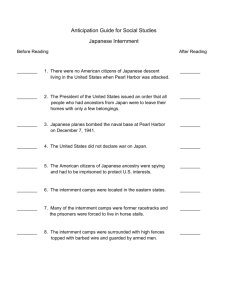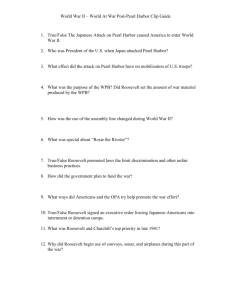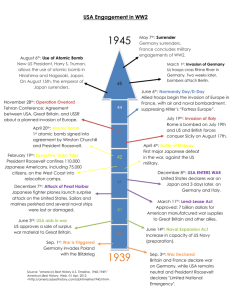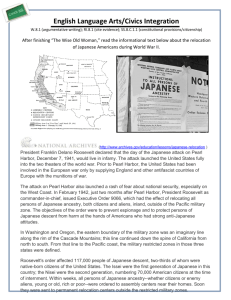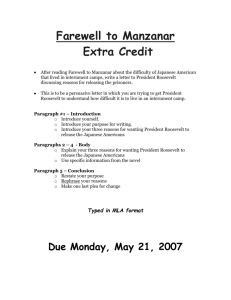Unit I Spiral Exam – World War II (75 points total) PLEASE DO NO
advertisement
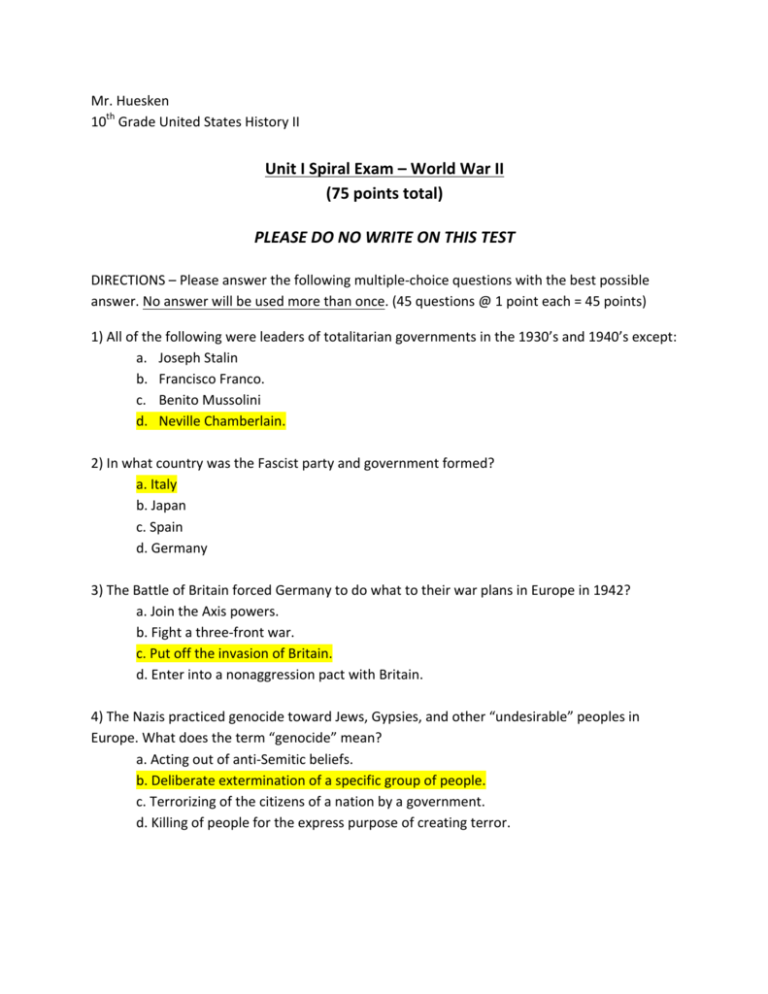
Mr. Huesken 10th Grade United States History II Unit I Spiral Exam – World War II (75 points total) PLEASE DO NO WRITE ON THIS TEST DIRECTIONS – Please answer the following multiple-­‐choice questions with the best possible answer. No answer will be used more than once. (45 questions @ 1 point each = 45 points) 1) All of the following were leaders of totalitarian governments in the 1930’s and 1940’s except: a. Joseph Stalin b. Francisco Franco. c. Benito Mussolini d. Neville Chamberlain. 2) In what country was the Fascist party and government formed? a. Italy b. Japan c. Spain d. Germany 3) The Battle of Britain forced Germany to do what to their war plans in Europe in 1942? a. Join the Axis powers. b. Fight a three-­‐front war. c. Put off the invasion of Britain. d. Enter into a nonaggression pact with Britain. 4) The Nazis practiced genocide toward Jews, Gypsies, and other “undesirable” peoples in Europe. What does the term “genocide” mean? a. Acting out of anti-­‐Semitic beliefs. b. Deliberate extermination of a specific group of people. c. Terrorizing of the citizens of a nation by a government. d. Killing of people for the express purpose of creating terror. 5) The term “blitzkrieg” was a military strategy that depended on what? a. A system of fortifications. b. Out-­‐waiting the opponent. c. Surprise and quick, overwhelming force. d. The ability to make a long, steady advance. 6) In an effort to avoid a second “world war”, when did the Britain and France adopt a policy of appeasement toward Germany? a. Before the war began. b. When they declared war. c. When the United States declared war. d. After France was invaded and divided. 7) The United States entered World War II as a direct result of what? a. The attack on Pearl Harbor. b. The invasion and division of France. c. The invasion and division of Poland. d. Attacks on U.S. ships in the Atlantic. 8) Which of the following was a false promise from Hitler not to take any more land in Europe? a. The Munich Pact b. The Atlantic Charter c. The Lend-­‐Lease Act d. The Treaty of Versailles 9) Which of the following matches a nation with that it invaded in the 1930s—before World War II was declared? a. Italy—Czechoslovakia b. Italy –Ethiopia c. Soviet Union –Ireland d. Japan-­‐-­‐the United States 10) Which nations came to be known as the Axis powers after they signed a mutual defense treaty in 1940? a. Germany, Japan, and Italy b. Germany, Japan, and Spain c. Germany, Italy, and Austria d. Germany, Italy, and the Soviet Union 11) What was the meaning of the Japanese term “kamikaze”? a. “divine wave” b. “holy wind” c. “divine wind” d. “holy war” 12) The Axis powers’ alliance worried Franklin D. Roosevelt because he saw that the United States, if drawn into the war, would have to a. Join the Allies. b. Fight on U.S. soil. c. Fight on two oceans. d. Take in millions of refugees. 13) In following a policy of appeasement, Britain and France were taking what controversial action(s)? a. Declaring war on Germany. b. Giving in to Hitler’s demands. c. Entering into a formal defense alliance. d. Pressuring the United States to enter the war. 14) The title of Hitler’s book, Mein Kampf, in English means what? a. “Well-­‐Being.” b. “My Country.” c. “My Struggle.” d. “Master Race.” 15) Hitler’s main method for achieving “lebensraum” or “living space” for the German people was to do what? a. Demand dictatorial power. b. Attack Jews. c. Form a secret police force. d. Conquer other countries. 16) Which of the following was the leader of Japan’s dictatorial government during the 1930’s and 1940’s? a. Adolph Hitler b. Francisco Franco c. Benito Mussolini d. Hideki Tojo 17) The Munich Conference was held to address the problem of a German threat to which nation? a. Poland. b. Hungary. c. Austria. d. Czechoslovakia. 18) Which of the following features did Nazi society stress to its citizens? a. Nationalism b. Isolationism c. Individual rights d. A classless society 19) The Weimar Republic was the post-­‐World War I government of what European country? a. France. b. Russia. c. Poland. d. Germany. 20) Il Duce was the title of which of the following totalitarian leaders of World War II Europe? a. Josef Stalin b. Adolf Hitler c. Haile Selassie d. Benito Mussolini 21) Which country invaded Rhineland in 1936, touching of a series of events that would eventually lead to the start of World War II? a. Italy b. Japan c. Germany d. the Soviet Union 22) Which country invaded China in 1938 as part of a mass campaign of territorial expansion? a. Italy b. Japan c. Germany d. The Soviet Union 23) The Germans first successfully used the blitzkrieg tactics in an attack on what eastern European country, which helped to also set off World War II? a. France. b. Poland. c. Finland. d. The Soviet Union. 24) Who was General Charles de Gaulle? a. The French general who negotiated France’s terms of surrender b. The prime minister of France before World War II c. The prime minister of the puppet government in southern France during World War II d. The leader of the French government-­‐in-­‐exile and the French during World War II 25) Which of the following technologies for the British helped to give them an advantage in the fighting of the Battle of Britain? a. Radar. b. Enigma code. c. British morale. d. More aircraft. 26) What technological development (originally discarded by the Western powers, but utilized by the Japanese) helped make the attack on Pearl Harbor possible? a. Attack submarines b. Heavy bombers c. Accurate radar d. Aircraft carriers 27) Who takes credit for and created the plan for the attack on the US naval base at Pearl Harbor? a. Hideki Tojo b. Emperor Hirohito c. Isoroku Yamamoto d. Ichiro Suzuki 28) Built following the destructive conclusion to the First World War and supported by a massive propaganda campaign, what was the intended purpose of the Maginot Line? a. To protect France from German invasion b. To protect Germany from Austrian invasion c. To protect France from Italian invasion d. To protect Britain from German invasion 29) Which of the following statements most accurately reflects Roosevelt’s feelings toward the events in Europe prior to 1941? a. Agreed with the isolationists and promoted an isolationist policy. b. Wanted to help the Allies, but had to appease U.S. citizens who opposed the war. c. Wanted to avoid the war because he did not see it as a threat to the United States. d. He did not understand the position of isolationists and was eager to join the war. 30) What was the Lend-­‐Lease Act? a. A statement of war aims compiled by Roosevelt and Churchill b. A nonaggression pact between Germany and the Soviet Union c. A policy allowing the president to provide arms to certain foreign countries d. An order to shoot German U-­‐boats on sight 31) What was the name given by Hitler to his supposed “master race”? a. Uebermenschen b. Aryans c. Untermenschen d. Einsatzgruppen 32) Which of the following methods did the German Schutzstaffel (SS) employ to deal with those considered “undesirables” in Nazi Germany or Nazi-­‐controlled areas? a. Death camps b. Deportation c. Concentration camps d. All of the above 33) What phrase was used by the Supreme Court to justify internment of Japanese-­‐Americans following the attack on Pearl Harbor? a. “Military necessity” b. “Military security” c. “National defense” d. “Guaranteed security” 34) The strategy of “island hopping” in the Pacific, which was developed by a joint US Army-­‐ Navy command, involved Allied attacks on what? a. All Japanese-­‐held islands. b. All islands within 500 miles of Japan. c. Only islands that were not well defended and offered strategic advantages. d. Only islands that were Japanese strongholds with fresh water supplies. 35) What legal means did the US government / President Roosevelt use to issue the internment of Japanese-­‐Americans during World War II? a. Signed a bill b. Passed a law c. Issued an executive order d. Proclaimed a national holiday 36) Who was the supreme commander of the Allied forces in Europe during World War II, much to annoyance of our British allies? a. George Patton b. Erwin Rommel c. Bernard Montgomery d. Dwight D. Eisenhower 37) Knowing that the Nazis were expecting an invasion of Europe at some point, what region of France was chosen for the D-­‐Day invasion? a. Calais b. Normandy c. Belgium d. Caucasus 38) Following the Battle of Bataan and the Japanese invasion of the Philippines, who went on the Bataan Death March, and why? a. Japanese soldiers, because they refused to surrender b. Allied prisoners of war, because the Japanese forced them to c. Allied soldiers, because it was essential to the success of the “island-­‐hopping” strategy d. Chinese civilians, because they were forced off their land by the Japanese invasion 39) What is the Allies’ codename for the invasion of Nazi-­‐occupied France? a. “Operation Overlord” b. “Operation Torch” c. “Operation of Barbarossa” d. “Operation Cobra” 40) What town was American troops (like the 101st Airborne Brigade) defending during the Battle of the Bulge, at one point completely cut off from the rest of the Allied army? a. Paris b. Antwerp c. Calais d. Bastogne 41) Known as the “Spartan General”, this general commanded the British forces in North Africa during World War II? a. Eisenhower b. Bradley c. Patton d. Montgomery 42) What is the codename for the Allied invasion of North Africa, where American troops got their first takes of action against German / Axis forces? a. “Operation Overload” b. “Operation Cobra” c. “Operation Torch” d. “Operation Camel” 43) What are the German troops in North Africa who became legendary for their ability to fight in hostile desert settings? a. Luftwaffe Afrikaner b. Wehrmacht Afrikaner c. Afrika Korps d. Afrika Staffel 44) Probably one of the most respected German generals of the European conflict, what was Erwin Rommel’s nickname? a. “desert camel” b. “desert shadow” c. “desert fox” d. “desert gecko” 45) Who created the theories that lead to the atomic bomb and the creation of the US Manhattan Project? a. Albert Einstein b. Enrico Fermi c. J. Robert Oppenheimer d. Warner von Braun Map Section – Part I: European Theater Great Britain Moscow Adriatic Sea Paris Norway London Czechoslovakia Warsaw Switzerland Poland Mediterranean Sea Iceland Rome North Sea Germany Spain English Channel Italy East Prussia Latvia Finland Austria Greece Albania DIRECTIONS – Use the word bank and process of elimination to locate the following items on the attached map. Each item will only be used once. (1 point each = 10 points) 1) Czechoslovakia 2) Finland 3) Warsaw 4) Moscow 5) Austria 6) North Sea 7) Adriatic Sea 8) East Prussia 9) Poland 10) Norway Map Section – Part II: Pacific Theater Coral Sea Hawaiian Island South China Sea Midway Island Indian Ocean Bering Sea Solomon Island Aleutian Islands Tokyo Soviet Union The Dutch East Indies Nanking Formosa China Mongolia Korea Manchuria Japan Thailand Burma Manila Iwo Jima Australia Okinawa DIRECTIONS – Use the word bank and process of elimination to locate the following items on the attached map. Each item will only be used once. (1 point each = 10 points) 11) Formosa 12) Australia 13) Manchuria 14) Korea 15) South China Sea 16) Indian Ocean 17) Aleutian Islands 18) Japan 19) Bering Sea 20) Solomon Islands Essay Questions DIRECTIONS – Please select ONE (1) of the following essay topics to complete your exam on a separate piece of paper, making sure the questions are answered fully and in complete sentences. (1 question @ 10 points = 10 points) 1) Who is to blame for Pearl Harbor? Following the deadly attack on the US naval base at Pearl Harbor, Hawaii, many Americans asked the questions of whether or not someone was the blame (other than the Japanese, of course) for the deadly surprise attack, such as US President Franklin Roosevelt. To complete this prompt, address the following points: • Why was the attack on Pearl Harbor a significant event in American history? Explain. • In your opinion, what caused conspiracy theories about this event to grow? Explain. • In your opinion, do you believe President Roosevelt was to blame for the attack on Pearl Harbor? Why or why not? (Cite three [3] pieces of specific evidence) • Should the conspiracy theorists be proven correct, how might the discovery of Roosevelt’s role in the Pearl Harbor attack change the course of US / World history? Explain. 2) Japanese Internment: During the early moths of the Pacific War, Japanese-­‐Americans (viewed with suspicion by many Americans) were rounded up and “interred” in isolated camps in the American Southwest. To complete this prompt, address the following points: • Why were American so suspicious / scared of Japanese-­‐Americans in the aftermath of Pearl Harbor? Explain. • How did President Roosevelt justify such an action using his powers as President of the United States? How did Congress? How did the public? Explain. • Why did many natural / naturalized Japanese-­‐Americans go along with the internment orders, even though it meant imprisonment, loss of property, etc.? Explain. • In your opinion, what lessons can we learn for the internment experience? What dangers should we be aware of? Explain. 3) Dr. Seuss and American Isolationism: During the early years of World War II, the United States remains neutral in the growing conflicts in Europe and Asia, much to the pains of some. To complete this prompt, address the following points: • Despite President Roosevelt’s desire to get into the war, the US was deeply isolationist. Explain why many Americans wanted to stay out of another war. • One of the great political cartoon voices of the period was Dr. Seuss, the acclaimed children’s author. Looking at his cartoon to the right, does Dr. Seuss support American neutrality? What in the cartoon expresses that position? Explain. • Despite America’s deep opposition to war, what was one (1) of the ways that President Roosevelt still assist the Allies (particularly Britain) or helped to get American ready to entry into the Second World War? Explain your answer.



